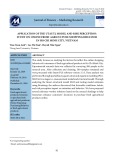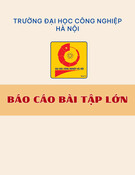Chapter 2
McGrawHill/Irwin
Copyright © 2014 by The McGrawHill Companies, Inc. All rights reserved.
Descriptive Statistics: Tabular and Graphical Methods
Descriptive Statistics
2.1 Graphically Summarizing Qualitative
Data
2.2 Graphically Summarizing Quantitative
22
Data 2.3 Dot Plots 2.4 StemandLeaf Displays 2.5 Crosstabulation Tables (Optional) 2.6 Scatter Plots (Optional) 2.7 Misleading Graphs and Charts (Optional)
LO2-1: Summarize qualitative data by using frequency distributions, bar charts, and pie charts.
2.1 Graphically Summarizing Qualitative Data
With qualitative data, names identify the
This data can be summarized using a
different categories
Frequency distribution: A table that
frequency distribution
23
summarizes the number of items in each of several nonoverlapping classes
LO2-1
Bar Charts and Pie Charts
Bar chart: A vertical or horizontal rectangle represents the frequency for each category ◦Height can be frequency, relative frequency, or
percent frequency
Pie chart: A circle divided into slices where the size of each slice represents its relative frequency or percent frequency
24
LO2-2: Construct and interpret Pareto charts (Optional).
Pareto Chart
Pareto chart: A bar chart having the different kinds of defects listed on the horizontal scale
Bar height represents the frequency of
Bars are arranged in decreasing height from
occurrence
Sometimes augmented by plotting a
left to right
25
cumulative percentage point for each bar
LO2-3 Summarize quantitative data by using frequency distributions, histograms, frequency polygons, and ogives.
2.2 Graphically Summarizing Qualitative Data
Often need to summarize and describe the
One way is to group the measurements into
shape of the distribution
After grouping them, we can display the data
classes of a frequency distribution
26
in the form of a histogram
LO2-3
Frequency Distribution
A frequency distribution is a list of data
classes with the count of values that belong to each class ◦“Classify and count” ◦The frequency distribution is a table Show the frequency distribution in a
distribution
27
histogram ◦The histogram is a picture of the frequency
LO2-4 Construct and interpret dot plots.
2.3 Dot Plots
28
Figure 2.18
LO2-5 Construct and interpret stem-and- leaf displays.
2.4 StemandLeaf Displays
Purpose is to see the overall pattern of the
data, by grouping the data into classes ◦the variation from class to class ◦the amount of data in each class ◦the distribution of the data within each class Best for small to moderately sized data
29
distributions
LO2-6 Examine the relationships between variables by using cross- tabulation tables. (Optional)
2.5 Crosstabulation Tables (Optional)
Classifies data on two dimensions
◦Rows classify according to one dimension ◦Columns classify according to a second
dimension
Requires three variable
◦The row variable ◦The column variable ◦The variable counted in the cells
210
LO2-7 Examine the relationships between variables by using scatter plots (Optional).
2.6 Scatter Plots (Optional)
Used to study relationships between two
Place one variable on the xaxis Place a second variable on the yaxis Place dot on pair coordinates
211
variables
LO8 Recognize misleading graphs and charts (Optional).
2.7 Misleading Graphs and Charts: (Optional)
212
Figure 2.32


























